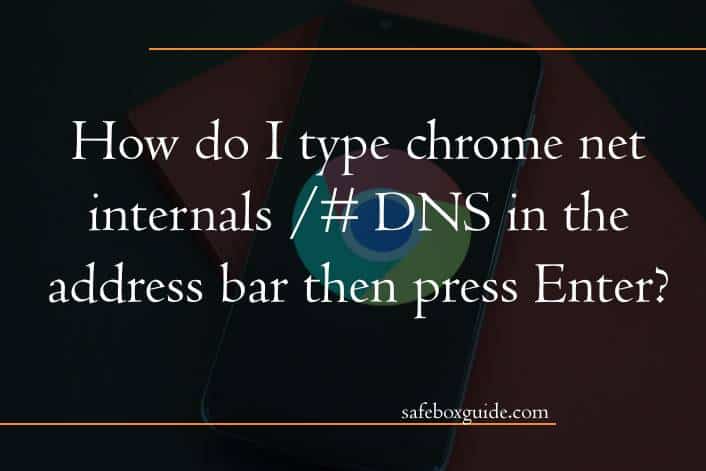Have you ever found yourself deep in the labyrinth of browser settings, desperately seeking a solution to a networking issue? The world of web browsers is vast and intricate, with hidden features waiting to be discovered by adventurous users. One such enigma lies within Google Chrome’s inner workings – the ‘chrome://net-internals/#dns’ command. But fear not, for today we embark on a journey to unravel this mystery and learn how to wield its power from the comfort of your address bar.
Contents
Accessing Chrome net internals page
When accessing the Chrome net internals page, users are granted a behind-the-scenes look at their browser’s inner workings. This powerful tool allows for detailed analysis of network activities, DNS resolutions, and performance metrics. By typing chrome://net-internals in the address bar and pressing Enter, users unlock a treasure trove of information that can help troubleshoot connectivity issues, track network requests, and optimize browsing speed.
One interesting feature of the net internals page is its ability to monitor WebSocket connections in real-time. This can be particularly useful for developers debugging web applications or users curious about the technologies powering their favorite sites. Additionally, by exploring the various tabs within net internals, such as Proxy Settings or HSTS Status, users can gain valuable insights into how Chrome manages security protocols and handles network configurations behind the scenes. Accessing this level of transparency not only enhances user understanding but also empowers them to take control of their browsing experience with a deeper knowledge of Chrome’s intricate networking mechanisms.

Navigating to the DNS section within Chrome’s internal settings can unveil a trove of valuable information about your browsing experience. This often-overlooked feature allows users to gain insights into how their system interprets domain names and maps them to corresponding IP addresses. By typing chrome://net-internals/#dns in the address bar and hitting Enter, users are transported into the heart of their browser’s Domain Name System operations.
Understanding the intricacies of DNS can empower users to troubleshoot connectivity issues, optimize browsing speed, and enhance overall security. The DNS section provides a dynamic interface that displays detailed information on cached host configurations, query performance, and network errors. With this access, users can make informed decisions on clearing cache, debugging network problems, or even refining their privacy settings. By delving into this realm of net internals, users can elevate their browsing experience to new levels of efficiency and control.
Interpreting DNS data in Chrome
When interpreting DNS data in Chrome, users can gain valuable insights into the domain name resolution process. By typing chrome://net-internals/#dns in the browser’s address bar and pressing Enter, a detailed log of DNS activity is displayed. This information includes cached DNS entries, host mappings, time-to-live values, and query statistics.
One interesting aspect to note is the presence of multiple types of DNS records that are stored in Chrome’s cache. Understanding the significance of each record type can help users troubleshoot network issues more effectively. Additionally, by analyzing the timestamps associated with each entry, users can track when DNS queries were made and identify any delays or errors impacting web page loading times.
By delving into the DNS data provided by Chrome’s internal tools, users can not only improve their browsing experience but also enhance their overall understanding of how websites are accessed on the internet. This level of transparency allows for a deeper insight into network performance and aids in diagnosing potential connectivity issues efficiently.
![]()
Troubleshooting using DNS information
As we delve into the intricate world of troubleshooting using DNS information, we uncover a powerful tool that can aid us in diagnosing and resolving connectivity issues. By typing chrome://net-internals/#dns in the address bar and hitting Enter, we unlock a treasure trove of DNS data that can provide valuable insights into network performance.
Understanding the DNS information displayed can help pinpoint issues such as incorrect configurations, slow resolution times, or even potential security threats. By analyzing this data with precision and expertise, one can make informed decisions to optimize network efficiency and security measures. Delving deep into the nuances of DNS settings opens up a realm of possibilities for enhancing online experiences and ensuring seamless connectivity across various platforms.
Importance of understanding Chrome net internals DNS
Understanding Chrome net internals DNS is crucial for optimizing browsing performance and troubleshooting network issues effectively. By delving into the DNS information provided in Chrome’s internal settings, users can gain valuable insights into how their browser resolves domain names and establishes connections with servers. This understanding allows users to identify potential bottlenecks in the browsing experience, such as slow loading times or connection errors, and take proactive steps to address them.
Additionally, exploring Chrome net internals DNS can help users enhance their online security and privacy. By examining the DNS prefetching information and querying statistics within Chrome’s internal settings, users can track which domains their browser is communicating with and detect any unusual or potentially malicious activity. This level of transparency empowers users to make informed decisions about their online activities and protect themselves from potential cybersecurity threats.
In conclusion, diving into Chrome net internals DNS offers a wealth of benefits beyond just technical knowledge. It provides users with the tools they need to optimize their browsing experience, troubleshoot network issues efficiently, and safeguard their online security. Therefore, taking the time to explore this aspect of Chrome’s internal settings can ultimately lead to a smoother, safer, and more enjoyable browsing experience for all users.

Conclusion: Enhancing browsing experience through DNS knowledge
By delving into the intricacies of Domain Name System (DNS) and understanding how it impacts web browsing, users can significantly enhance their online experience. The ability to access Chrome’s internal DNS settings opens up a world of customization possibilities that can streamline browsing speeds, improve security measures, and optimize website loading times. By utilizing this knowledge effectively, users can troubleshoot connection issues, block malicious websites more efficiently, and even prioritize certain domains for faster loading.
Furthermore, being equipped with DNS knowledge not only empowers users to take control of their browsing experience but also helps them navigate the complexities of the internet with greater ease. Understanding how DNS resolves domain names into IP addresses allows individuals to make informed decisions when it comes to configuring their network settings or choosing a reliable DNS server. Ultimately, by integrating this technical know-how into their daily browsing habits, users can transform mundane internet surfing into a seamless and tailored journey through cyberspace.

